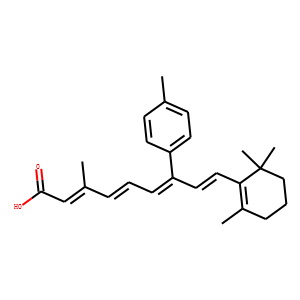| InChI | InChI=1S/C26H32O2/c1-19-11-13-23(14-12-19)22(10-6-8-20(2)18-25(27)28)15-16-24-21(3)9-7-17-26(24,4)5/h6,8,10-16,18H,7,9,17H2,1-5H3,(H,27,28)/b8-6+,16-15+,20-18+,22-10- |
| Reference | 1. Cancer Microenviron. 2017 Nov 24. doi: 10.1007/s12307-017-0202-0. [Epub ahead of
print]
<br>
SR 11302, an AP-1 Inhibitor, Reduces Metastatic Lesion Formation in Ex Vivo 4D
Lung Cancer Model.
<br>
Mishra DK(1), Kim MP(2)(3).
<br>
Author information: <br>
(1)Department of Surgery, Houston Methodist Research Institute, 6670 Bertner Ave,
Houston, TX, 77030, USA. [email protected].
(2)Department of Surgery, Houston Methodist Research Institute, 6670 Bertner Ave,
Houston, TX, 77030, USA.
(3)Department of Surgery, Weill Cornell Medical College, Houston Methodist
Hospital, Houston, TX, 77030, USA.
<br>
Activator protein (AP) -1 is a transcription factor, plays important role in cell
differentiation, proliferation and apoptosis. Analysis of tumor cells grown on ex
vivo 4D lung cancer model shows increase in components of AP-1, c-Fos and c-Jun
in circulating tumor cells (CTC) compared to primary tumor. Our aim was to
determine whether the AP-1 inhibitor SR11302 reduces metastatic lesion formation
in the 4D model. Human lung cancer cell lines A549, H1299, and H460 were grown in
the 4D model and treated with SR11302 (1 μM). We compared the number of cells in
the metastatic site upon SR11302 treatment and number of viable CTCs isolated
from the 4D model with parental cells treated/untreated with SR11302 on a petri
dish. There were significantly fewer tumor cells per high-power field on
metastatic site in 4D model seeded with H460 (p = 0.009), A549 (p = 0.01), or
H1299 (p = 0.02) cells treated with SR11302. Furthermore, the CTCs from SR11302
treated 4D models, seeded with H460 (p = 0.04), A549 (p = 0.008), or H1299
(p = 0.01) cells had significantly fewer viable tumor cells after 4 days in
culture than the respective untreated control. However, the SR11302 had no impact
on the viability of parental H460 (p = 0.87), A549 (p = 0.93), or H1299
(p = 0.25) cells grown on a petri dish (2D). SR11302 reduces metastatic lesion
formation in the ex vivo 4D lung cancer model due to the presence of an
independent yet common pathway among three cell lines. The ex vivo 4D model may
provide a tool to better understand the complex process of metastasis.
<br>
2. PLoS One. 2016 Aug 4;11(8):e0160525. doi: 10.1371/journal.pone.0160525.
eCollection 2016.
<br>
AP-1 Inhibition by SR 11302 Protects Human Hepatoma HepG2 Cells from Bile
Acid-Induced Cytotoxicity by Restoring the NOS-3 Expression.
<br>
González-Rubio S(1), Linares CI(1), Aguilar-Melero P(1), Rodríguez-Perálvarez
M(1)(2), Montero-álvarez JL(1)(2), de la Mata M(1)(2), Ferrín G(1)(2).
<br>
Author information: <br>
(1)Maimonides Institute of Biomedical Research in Córdoba (IMIBIC), Reina Sofía
University Hospital, University of Córdoba, Córdoba, Spain.
(2)Biomedical Research Centre Network, Digestive and Liver Diseases (CIBEREHD),
Instituto de Salud Carlos III, Córdoba, Spain.
<br>
The harmful effects of bile acid accumulation occurring during cholestatic liver
diseases have been associated with oxidative stress increase and endothelial
nitric oxide synthase (NOS-3) expression decrease in liver cells. We have
previously reported that glycochenodeoxycholic acid (GCDCA) down-regulates gene
expression by increasing SP1 binding to the NOS-3 promoter in an oxidative stress
dependent manner. In the present study, we aimed to investigate the role of
transcription factor (TF) AP-1 on the NOS-3 deregulation during GCDCA-induced
cholestasis. The cytotoxic response to GCDCA was characterized by 1) the
increased expression and activation of TFs cJun and c-Fos; 2) a higher binding
capability of these at position -666 of the NOS-3 promoter; 3) a decrease of the
transcriptional activity of the promoter and the expression and activity of
NOS-3; and 4) the expression increase of cyclin D1. Specific inhibition of AP-1
by the retinoid SR 11302 counteracted the cytotoxic effects induced by GCDCA
while promoting NOS-3 expression recovery and cyclin D1 reduction. NOS activity
inhibition by L-NAME inhibited the protective effect of SR 11302. Inducible NOS
isoform was no detected in this experimental model of cholestasis. Our data
provide direct evidence for the involvement of AP-1 in the NOS-3 expression
regulation during cholestasis and define a critical role for NOS-3 in regulating
the expression of cyclin D1 during the cell damage induced by bile acids. AP-1
appears as a potential therapeutic target in cholestatic liver diseases given its
role as a transcriptional repressor of NOS-3.
<br>
|

